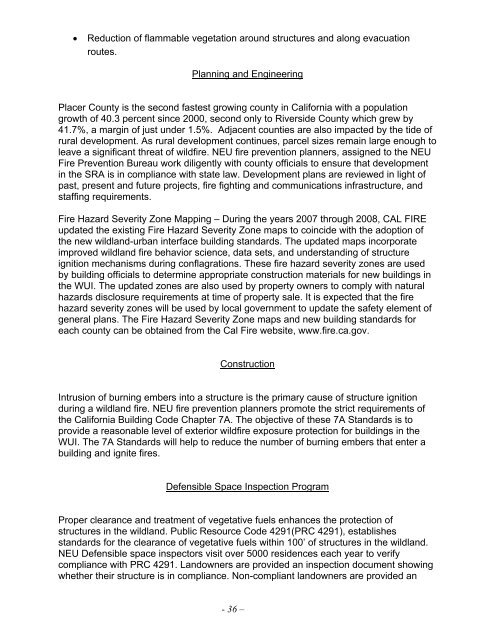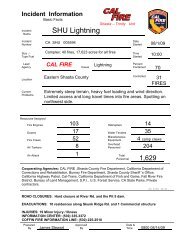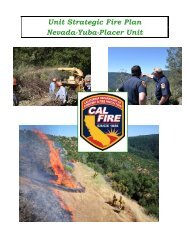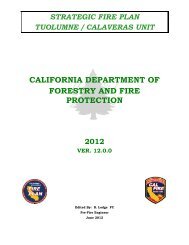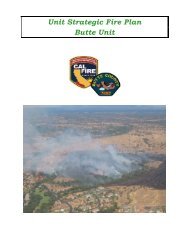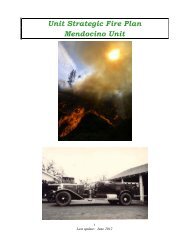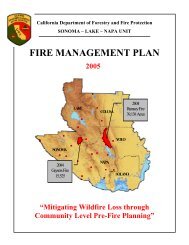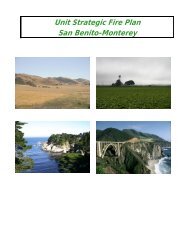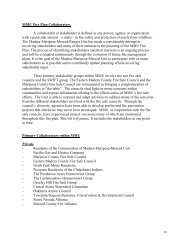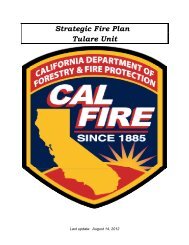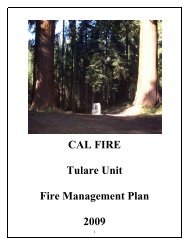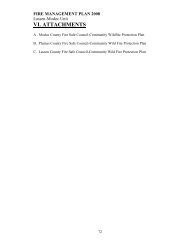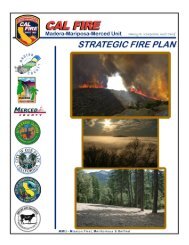Nevada-Yuba-Placer Strategic Fire Plan 2011 - Board of Forestry ...
Nevada-Yuba-Placer Strategic Fire Plan 2011 - Board of Forestry ...
Nevada-Yuba-Placer Strategic Fire Plan 2011 - Board of Forestry ...
You also want an ePaper? Increase the reach of your titles
YUMPU automatically turns print PDFs into web optimized ePapers that Google loves.
• Reduction <strong>of</strong> flammable vegetation around structures and along evacuation<br />
routes.<br />
<strong>Plan</strong>ning and Engineering<br />
<strong>Placer</strong> County is the second fastest growing county in California with a population<br />
growth <strong>of</strong> 40.3 percent since 2000, second only to Riverside County which grew by<br />
41.7%, a margin <strong>of</strong> just under 1.5%. Adjacent counties are also impacted by the tide <strong>of</strong><br />
rural development. As rural development continues, parcel sizes remain large enough to<br />
leave a significant threat <strong>of</strong> wildfire. NEU fire prevention planners, assigned to the NEU<br />
<strong>Fire</strong> Prevention Bureau work diligently with county <strong>of</strong>ficials to ensure that development<br />
in the SRA is in compliance with state law. Development plans are reviewed in light <strong>of</strong><br />
past, present and future projects, fire fighting and communications infrastructure, and<br />
staffing requirements.<br />
<strong>Fire</strong> Hazard Severity Zone Mapping – During the years 2007 through 2008, CAL FIRE<br />
updated the existing <strong>Fire</strong> Hazard Severity Zone maps to coincide with the adoption <strong>of</strong><br />
the new wildland-urban interface building standards. The updated maps incorporate<br />
improved wildland fire behavior science, data sets, and understanding <strong>of</strong> structure<br />
ignition mechanisms during conflagrations. These fire hazard severity zones are used<br />
by building <strong>of</strong>ficials to determine appropriate construction materials for new buildings in<br />
the WUI. The updated zones are also used by property owners to comply with natural<br />
hazards disclosure requirements at time <strong>of</strong> property sale. It is expected that the fire<br />
hazard severity zones will be used by local government to update the safety element <strong>of</strong><br />
general plans. The <strong>Fire</strong> Hazard Severity Zone maps and new building standards for<br />
each county can be obtained from the Cal <strong>Fire</strong> website, www.fire.ca.gov.<br />
Construction<br />
Intrusion <strong>of</strong> burning embers into a structure is the primary cause <strong>of</strong> structure ignition<br />
during a wildland fire. NEU fire prevention planners promote the strict requirements <strong>of</strong><br />
the California Building Code Chapter 7A. The objective <strong>of</strong> these 7A Standards is to<br />
provide a reasonable level <strong>of</strong> exterior wildfire exposure protection for buildings in the<br />
WUI. The 7A Standards will help to reduce the number <strong>of</strong> burning embers that enter a<br />
building and ignite fires.<br />
Defensible Space Inspection Program<br />
Proper clearance and treatment <strong>of</strong> vegetative fuels enhances the protection <strong>of</strong><br />
structures in the wildland. Public Resource Code 4291(PRC 4291), establishes<br />
standards for the clearance <strong>of</strong> vegetative fuels within 100’ <strong>of</strong> structures in the wildland.<br />
NEU Defensible space inspectors visit over 5000 residences each year to verify<br />
compliance with PRC 4291. Landowners are provided an inspection document showing<br />
whether their structure is in compliance. Non-compliant landowners are provided an<br />
- 36 –


